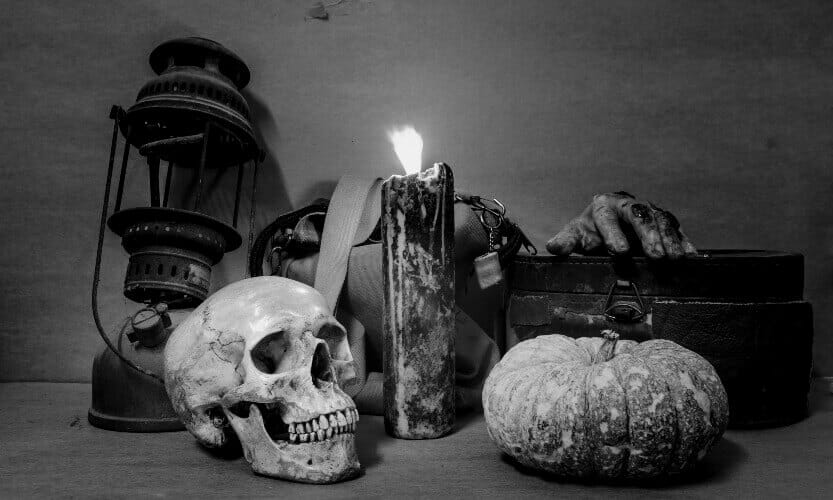Suspense, action, and darkness are three crucial elements of a gripping thriller.
This guide will take you through the various types of thrillers out there, from psychological to political, and give you some top tips to create your own edge-of-the-seat whirlwind thriller novel.
What Is A Thriller?
Thriller novels are generally plot-driven narratives, with complex, morally grey characters, featuring suspense, action, and an exploration of the dark side of human nature.
Good thrillers are pacy and tight, leading the reader through a twisty plot and building to a breakneck speed.
What Is the Difference Between Thrillers, Mysteries and Suspense Fiction?
There are many crossover elements between thrillers, mysteries and suspense fiction. Things they are likely to all have in common include:
- A focus on building tension
- A fast pace
- A plot revolving around crime
However, there are key differences as well. While mystery novels use a central question or investigation to move the plot forward, paying off with a reveal at the end of whodunnit, the thriller genre may not hide who the villains and antagonists are; they may even be a central focus of the plot.
A suspense novel may have a similar focus, but it is driven by character rather than action. Many, or even most, thrillers will have chases, surprise attacks, and a race against time… while suspense novels are often ‘quieter’ and focused on the interior experience of the characters.
That’s not to say that thrillers cannot have shocking revelations or complex characters!
Let’s have a look at the different types of thrillers below.
Types Of Thrillers
Psychological Thriller
Along with action adventure and crime, psychological thrillers are one of the most well-recognised thriller subgenres.
Psychological thrillers are focused on the inner lives of characters who find themselves drawn into dangerous and threatening situations, either through chance or through a personality flaw or obsession.
Her, Mira V. Shah’s upcoming domestic suspense debut, perfectly encapsulates the approach of having an obsession spiral out of control, which is so often taken in psychological thrillers.
Rani’s obsession with her neighbour Natalie’s apparently perfect life escalates until both women’s lives are inextricably intertwined, and Rani has discovered that Natalie’s life might not be quite as idyllic as it seems. The tension and conflict that the two face provides the kind of gripping narrative that thrillers do so well, as the novel builds towards its inescapable conclusion.

Supernatural Thriller
Supernatural thrillers are having a bit of a heyday recently, popularly revived as they have been by the Duffer Brothers’ wildly successful Netflix series, Stranger Things.
Drawing heavily on classic supernatural thrillers by writers such as Stephen King, Stranger Things fits well in this subgenre with its evocation of fear, tension and dread.
Supernatural thrillers often contain elements of other genres, such as science-fiction, fantasy, horror, and the gothic.
Threats in supernatural thrillers are often unknowable creatures, who cannot be reasoned with or understood from a human perspective, resulting in situations where the dread is turned up to 11 as the main characters battle forces that they can barely comprehend.
Political Thriller
The essential ingredient of a political thriller is high stakes and plot twists. Many lives are at risk. High-level political figures are personally threatened. Often the protagonist is alone or becomes so – stripped of support, they must survive and defeat the antagonist(s) based on their wits and guts.
Stacey Abrams, best known for her political career in the United States, has also written a number of books under the pseudonym Selena Montgomery. Her most recent book, however, a political thriller titled While Justice Sleeps, is her first work of fiction published under her own name.
The story follows law clerk Avery, who is plunged into a world of intrigue and conspiracies after her boss, a high-level judge, slips into a coma and leaves her in charge of his affairs. The stakes couldn’t be higher as the trail takes Avery all the way to the top, with elements of mystery and suspense coming in as she discovers the truth behind one of the judge’s most high-profile cases.
Action-Adventure Thriller
Like political thrillers, action-adventure thrillers are high-paced, high-stakes, and high drama. Expect plenty of action set pieces, like chases, fights, and explosions (and more, averted at the last possible moment).
An example of this type of thriller is The Ninja Daughter, by Tori Eldridge. Lily Wong is a Chinese-Norwegian woman whose purpose in life is to defend abused women and children.
The novel is full of thrills and action, including fight and chase scenes, with a central mystery that builds to an explosive climax.
Cleverly riffing on the noir genre, Eldridge gives us a modern twist on the ‘femme fatale’ character, and this action thriller is full of excitement and tension.
Crime Thriller
A crime thriller is a subset of the crime genre, and, along with the typical elements of a focus on crime and the subsequent investigation, has the exciting elements of a thriller, with conflict and tension fuelling the pace of the narrative. Legal thrillers are also part of the crime thriller subgenre, and they emphasise courtroom proceedings and the legal aspects of crime.
Girl Zero, A. A. Dhand’s gritty and at times bleak crime thriller, utilises the central investigative element by having his main character, D. I. Harry Virdee, hunt for the murderer of his niece.
The thriller element is brought in with the pacing, as Harry and his gangster brother have to race against time to stop a child trafficking gang.
Investigative Thriller
Although this type of thriller may seem very similar to crime thrillers, the key difference is that the character leading the investigation is not from a traditional investigative background.
While a crime thriller will typically have a protagonist who is a police officer, or attached to the police in some manner, an investigative thriller will likely have someone pursuing the truth from a more unconventional angle.
Dark Pines is the first of Will Dean’s Tuva Moodyson series, about a Deaf journalist in a small Swedish town who is drawn into a decades-old mystery when two hunters are found, murdered in a manner similar to an unsolved case from long ago.
There is plenty of tension as Tuva grapples with the various conflicting loyalties of the villagers, as well as her desire to write the story of her career and break free from the life she feels trapped by.

Spy Thriller
Twists and turns are the name of the game in spy thrillers, where the central character is often at the centre of a web of lies, deceit and cover-ups at the highest levels.
Expect plenty of thrilling chase scenes, explosive conflicts, and death-defying escapes in this type of thriller, as well as continual surprises as motivations and loyalties are uncovered.
One of John Le Carré’s best-known spy thrillers is Tinker Tailor Soldier Spy, his 1974 novel starring his recurring character George Smiley. Smiley’s job in this book is to uncover a Soviet double agent within the British intelligence service. The trail leads him through twists and turns, through which almost no one can be trusted completely.
There is plenty of elegantly executed suspense in Le Carré’s work, and a complex plot that is set against the background of a waning empire, nicely dovetailing with his ageing protagonist. Both provide additional tension as the plot is eventually untangled and the secrets Smiley has been chasing are exposed.
Historical Thriller
Historical settings might be as far back as medieval times, as in Umberto Eco’s The Name of the Rose, or as recently as a few decades ago, like the TV series Life on Mars.
These settings are often excellent for increasing tension, as modern sleuthing methods like CCTV and digital databases are non-existent, and characters may have to battle against limiting social roles as well.
A recent excellent historical novel is The Confessions of Frannie Langton, by Sara Collins. There are many thriller elements to this historical narrative, as the central character is on trial for a crime she cannot remember committing.
As the child of an enslaved woman and her enslaver, Frannie is in a difficult social position. Although she is educated, she is also subject to the limitations and prejudices of racism, which impact how likely it is that her story will be believed. The historical setting of Collins’ novel allows her to delve into the dark side of humanity, as we also expect from thrillers.
How To Write A Thriller
So, how do you go about writing a good thriller? Looking at all the different types above, we can see that there are some commonalities among them that thriller writers should know.
1. Start With A Moment Of Change
Let us join your character at a moment of change in their life: whether that be a dramatic, explosive one (they’re hanging off a building! They’re chasing a suspect! They’ve been betrayed!) or a quiet, interior one (they’ve realised they’ve been mistaken about a small but crucial detail about their job/loved one/life), a character’s life is most interesting when it takes a turn.
2. Know What’s At Stake
It’s important early on that your readers know why your character’s goal is so important to them. If your character is working to uncover the truth about a murder, what is their personal connection to it?
It simply being their job to investigate it isn’t quite enough.
Perhaps it has some personal resonance with them due to a past experience, or there is a family or community connection. Perhaps they need to prove themselves in some way. Maybe there is a time pressure – thrillers often feature characters who have to race against time to solve something.
Whatever the stakes are, make them personal in some way to your character.
3. Ensure We Care About The Characters
Some stakes are very high and quite abstract – saving a building/city/country. Giving the character a loved one who is also personally at risk in some way helps to make this threat immediate and personal and contextualises the larger threat.
Equally, your character must be vulnerable in some way. As exciting as it is to read about a dapper hero skilfully knocking out bad guys, it becomes dull if there is no sense of personal danger to the character. Giving them something they love that is at risk is a good way to make them vulnerable, and ensure that the reader cares about them, too.

4. Gradually Increase The Suspense
Continually amp up the tension by gradually increasing the threat that the character faces.
These threats can also be made more daunting if your character has few resources to work with – taking these away over the course of the narrative will enable you to ratchet up that edge-of-your-seat feeling that you want your readers to have! Keep your readers guessing.
5. Make Limitations Work For You
Whether it be something intrinsic to the setting, such as a lack of modern policing technology; something external to the character, such as social attitudes or previous attributes being withdrawn (think of those ‘you’ve gone too far, hand in your gun and your badge’ scenes); or something that rises from the characterisation itself, such as physical injuries or psychological states, limitations are key to stacking the odds against your protagonist.
6. Build Up To The Climax
Stacking the odds even higher is an excellent way to build to a climax.
Your character should encounter ever-more daunting challenges, and be gradually stripped of help and resources until they are faced with overcoming something that seems insurmountable.
Your reader won’t be able to put your story down!
7. Ensure The Ending Is Satisfying
A satisfying ending might come from a crime being solved – the perpetrators brought to justice. Or it might be a disaster averted, the day saved, the love interest suitably impressed.
It might also be a situation where justice is not served, and the outcome isn’t entirely what the character wanted. The satisfaction then comes from character development and the emotional arc of the protagonist, who has gone through trials and come out changed in some way. Although they might not have won the war, a personal victory will leave your reader satisfied with the journey.
Thriller Writing Tips
These are our top tips for writing thrillers.
- Plot Twists. All should not be as it first seems: perhaps friends are not to be trusted, and rivals become allies. Perhaps your character’s understanding of the world is radically changed in some way with the discovery of key information.
- All Is Lost. At some point, your character should be faced with their dark night of the soul – it will seem as though their goal will never be met, their resources are gone, and their life has changed for the worse. Bringing your character back from their personal abyss makes the ending that much more satisfying.
- Play With Expectations. Much of the fun of a thriller is the unexpected elements of the plot. Embrace this by playing with your readers’ expectations. It might sound far-fetched for the hero of a spy thriller to be a Scottish granny, but Christopher Brookmyre made it happen in All Fun and Games Until Somebody Loses an Eye!

Frequently Asked Questions
What Are The Key Elements Of A Thriller?
Suspense, action and darkness are key elements in a thriller. Your readers expect thrills, tension, conflict, and an exploration of the darker side of human nature.
What Is The Structure Of A Thriller?
A gripping thriller follows the classic three-act structure. In the first act, the character is introduced, and the plot is set up. The second act adds complications, and the character suffers failures but also gets closer to their goal. The third act is the final showdown – the character is faced with defeating someone or something, and they may or may not be victorious in the way they originally imagined.
What Makes A Thriller successful?
Thrillers do just that – thrill. Readers want to be gripped, enthralled, fascinated, and horrified; they want to root for the success of the protagonist against all the odds. They want exciting events, overwhelming opposition, and a narrative that draws to a satisfying conclusion.
Writing Thrillers
As we have seen in the various types of thrillers we’ve looked at, there are many thriller elements in lots of different types of narratives.
Even if you’re not setting out to write a traditional thriller, you can still utilise a lot of the genre’s elements in domestic suspense, historical fiction, and crime writing.
Including the key thriller elements of suspense, action and darkness will add another dimension to any story, and provide your readers with a popular narrative style that will keep them gripped until the last page.
Jericho Writers is a global membership group for writers, providing everything you need to get published. Keep up with our news, membership offers, and updates by signing up to our newsletter. For more writing articles, take a look at our blog page.










